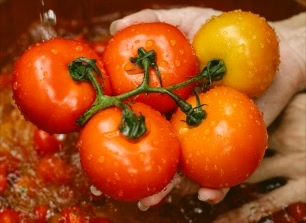The time it takes for tomatoes to turn red and ripen is very short, so farmers usually harvest them just as the lower edge of the tomato turns red. This means the fruit is still on the stem, not yet fully ripe, before being harvested. The tomatoes then gradually turn red as they travel, reaching full ripeness by the time they are released to the market.
Selecting sweet tomatoes from the stem
The fruit matures and turns red only after the seeds have matured. This is because the plant doesn’t want animals to eat them before the seeds are ripe. The fruit matures and becomes edible only after the seeds have matured and are capable of germinating.
The animals that consume the fruit then spread the seeds by spitting them out or excreting them. The fruit’s reddening and ripening indicates that the sugars produced by photosynthesis are concentrated in the fruit.
Pearl that is picked unripe has not yet been transported to that location, so tomatoes that turn red during distribution lack sweetness. Tomatoes grown without fertilizers are not distributed in a conventional manner, so they are not shipped until they have matured on the stem, resulting in a naturally sweet flavor. To determine whether a tomato is ripe before harvesting, look at the stem.
If a tomato is harvested after ripening, the tip of the stem will be pointed upward. The appearance of the stem alone can tell you how the tomato will taste.
How can you tell if a tomato has been treated with auxins?
Tomatoes are insect-pollinated, meaning they must be pollinated by insects to produce fruit. This pollination method requires the right conditions, but the current decline in bee populations has made pollination difficult. Without pollination, fruit cannot be produced, so some farmers use plant hormones to encourage pollination and fruiting.
Naturally, tomatoes secrete the plant hormone auxin after pollination, signaling the tomato to begin fruiting. There are commercially available synthetic auxins that, when used, cause plants in the Solanaceae family to produce fruit. However, these synthetic auxins are, of course, chemicals, not natural products.
To determine whether a tomato has been treated with auxins, look at the number of seeds within the tomato. If the seed count is extremely low, the likelihood of using this chemical is high, especially with greenhouse tomatoes grown outside of tomato season. This phenomenon is particularly pronounced.
A local cherry tomato with many seeds and a rich flavor.
An F1 cherry tomato with almost no seeds and an unnatural feel.
Another criterion for judging is that, like the white radish mentioned earlier, the growth process of plants follows certain patterns to a certain extent. For example, the cherry tomatoes still hanging on the branches are beautifully arranged in a staggered pattern.
When a cherry tomato grows on the right, another will grow below it on the left, and finally a small tomato will grow in the center. However, sometimes there is an imbalance between the left and right sides. Although cherry tomatoes sold on the branches are rare, this is also a criterion for judging.


Leave a Reply